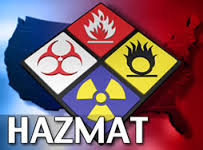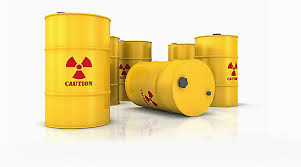Hazardous materials:
Introduction:
Hazardous materials (hazmat) are any material that has properties that may result in risk or injury to health and/or destruction of life or facilities. Many hazardous materials (hazmat) do not have a taste or an odor. Some can be detected because they cause physical reactions such as watering eyes or nausea. Some Hazardous Materials exist beneath the surface of the ground and have an oil or foam-like appearance. The substance can be identified from placards, labels or markings on the transporters.
Hazardous Material can be: ·
Corrosive Hazmat Materials:
are strong enough to eat away at steel drums or human skin. Because they can eat through the containers they are carried in, they are of special concern during transportation. Example: car battery acids ·
Ignitable Hazmat Materials:
present a fire hazard because they are flammable at relatively low temperatures. This causes a risk of explosion and the spreading of toxic gas over an area, as well as fire and smoke. Examples: paint removers, the chemical Benzene ·
Reactive Materials:
can explode or release deadly fumes by mixing with water or reacting to heat or pressure. Examples: old weapons and ammunition, sodium metal, stannic chloride ·
Radioactive Materials:
include materials with both high and low radioactivity that can lead to dangerous side effects for thousands of years. Most of these materials are produced at nuclear power plants and by research facilities. ·
Toxic Hazardous Materials:
consist of poisonous chemicals. People and animals exposed to these types of materials can develop severe health problems. Examples: lead, arsenic, mercury ·
Infectious Materials:
These materials are also toxic wastes, but are in a separate category. They consist of materials infected with some type of germ, bacteria, or virus that could cause disease in humans or animals. These types of materials often come from hospitals. Examples: hypodermic needles, human and animal waste.
Classification of Hazardous Materials:
The DOT has broad authority to regulate hazardous materials that are in transport, including the discretion to determine which materials shall be classified as "hazardous". These materials are placed in one of nine categories, based on their chemical and physical properties. Based on the classification of the material, the DOT is also responsible for determining the appropriate packaging materials for shipping or transport. Finally, also based on the material classification, strict guidelines are furnished for proper labeling/marking of packages of hazardous materials offered for transport, and for placarding of transport vehicles.
Class 1: Explosives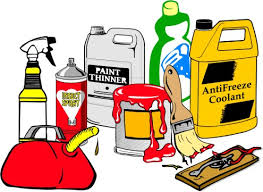
Division 1.1 - Articles and substances having a mass explosion hazard
Division 1.2 - Articles and substances having a projection hazard, but not a mass explosion hazard
Division 1.3 - Articles and substances having a fire hazard, a minor blast hazard, and/or a minor projection hazard, but not a mass explosion hazard
Division 1.4 - Articles and substances presenting no significant hazard (explosion limited to package)
Division 1.5 - Very insensitive substances having a mass explosion hazard
Division 1.6 - Extremely insensitive articles which do not have a mass explosion hazard
Class 2 Gas
Division 2.1 - Flammable Gas
Division 2.2 - Non-flammable, non-toxic gas (under pressure, inert, etc.)
Division 2.3 - Toxic Gas
Class 3 Flammable Liquids (100 Degrees F or less closed cup):
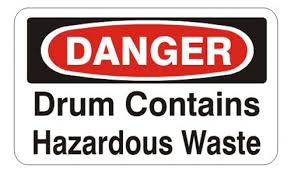
Class 4 Other Flammable Substances:
Division 4.1 - Flammable Solid
Division 4.2 - Substances liable to spontaneous combustion
Division 4.3 - Substances which, in contact with water, emit flammable gases
Class 5 Oxidizing Substances and Organic Peroxides:
Division 5.1 - Oxidizers
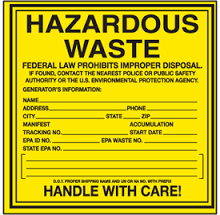
Division 5.2 - Organic Peroxides
Class 6 Toxic (Poisonous) and Infectious Substances:
Division 6.1 - Toxic Substances
Division 6.2 - Infectious Substances
Class 7 Radioactive Material:
Division 7 - Radioactive Material
Class 8 Corrosives: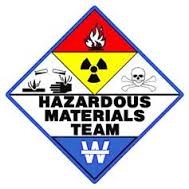
Division 8 - Corrosives
Class 9 Miscellaneous Dangerous Goods:
Magnetized material
Elevated temperature goods
Dry ice
Asbestos
Environmentally hazardous substances
Life-saving appliances
Engines, internal combustion
Polymeric beads
Battery-powered equipment or vehicle
Zinc Dithonite
Hazardous Material packing groups:
- Packing Group I – high danger
- Packing Group II – medium danger
- Packing Group III – Low danger
Division 4.1 Packing Groups:
Packing Group I – Pyrophoric liquids and solids.
Packing Group II – Positive test result when tested with a 25mm cube size sample at 140°C.
Packing Group III – If one of the following is true:
- A positive test is obtained in a test using a 100mm sample cube at 140°C and a negative test result is obtained in a test using a 25mm sample cube at 140°C and the substance is transported in packagings with a volume of more than 3 cubic meters.
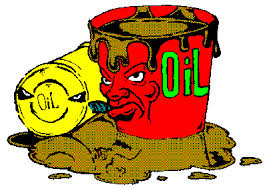
- A positive test result is obtained in a test using a 100mm sample cube at 120°C and a negative test result is obtained in a test using a 25mm sample cube at 140°C and the substance is transported in packagings with a volume of more than 450 liters.
- A positive test result is obtained in a test using a 100mm sample cube at 100°C and a negative test result is obtained in a test using a 25mm sample cube at 140°C and the substance is transported in packagings with a volume of less than 450 liter
Division 4.3 Packing Groups:
- Packing Group I – Material reacts vigorously with water at ambient temperatures and demonstrates a tendency for the gas produced to ignite spontaneously, or which reacts readily with water at ambient temperatures such that the rate of evolution of flammable gasses is equal or greater than 10 liters per kilogram of material over any one minute
- Packing Group II – Material reacts readily with water at ambient temperatures such that the maximum evolution rate of flammable gases is equal to or greater then 20 liters per kilogram of material per hour, and the material does not meet the criteria for PG I
- Packing Group III – Material reacts slowly with water at ambient temperatures such that the maximum evolution rate of flammable gases is greater than 1 liter per kilogram of material per hour, and the material does not meet criteria for PG I or II
Division 5.1 Packing Groups (liquids):
- Packing Group I – Any material that spontaneously ignites when mixed with cellulose in a 1:1 ratio or any material that exhibits a mean pressure rise time less than the pressure rise time of a 1:1 perchloric acid (50%):cellulose mixture
- Packing Group II – Material that exhibits a mean pressure rise time less than or equal to the pressure rise time of a 1:1 aqueous sodium chlorate solution (40%):cellulose mixture, and does not meet the criteria for PG I
- Packing Group III – Material that exhibits a mean pressure rise time less than or equal to the pressure rise time of a 1:1 nitric acid (65%):cellulose mixture, and does not meet the criteria for PG I or II.
Division 5.1 Packing Groups (solids):
- Packing Group I – Material that exhibits a mean burning time less than the mean burning time of 3:2 potassium bromate:cellulose mixture.
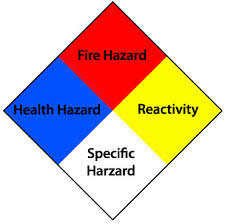
- Packing Group II – Material that exhibits a mean burning time less than or equal to the mean burning time of a 2:3 potassium bromate:cellulose mixture and does not meet the criteria for PG I.
- Packing Group III – Material that exhibits a mean burning time less than or equal to the mean burning time of a 3:7 potassium bromate:cellulose mixture and does not meet the criteria for PG I or II.
Division 6.1 Packing Groups:
For poisons which are not inhalation hazards:
Class 8 Packing Groups: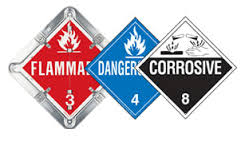
- Packing Group I – Material that causes full thickness destruction of intact skin tissue within 60 minutes, starting after an exposure time of three minutes or less.
- Packing Group II – Material that causes full thickness destruction of intact skin tissue within 14 days starting after an exposure time of more than three minutes but not more than 60 minutes.
- Packing Group III – Material that cause full thickness destruction of intact skin tissue within an observation period of up to 14 days starting after the exposure time of more than 60 minutes but not more than 4 hours
Hazardous Material Safety Transportation Security Plan:
Company Name 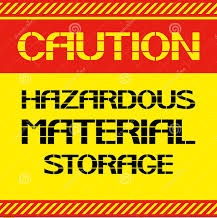
address 1 [Date]
address 2 [Version#]
City, State, Zip [Copy 1 of 20]
Phone [Copyright Information]
Fax
Table of Contents:
- Purpose Statement
- Scope of Operations
- List of Hazardous Materials
- Personnel and Organization
- Assessment Information
Risk Assessment 1
Risk assessment 2
- Security procedures
- Evaluation
Purpose Statement:
Company Name is committed to providing safe transport of hazardous materials. The company understands the heightened need for security to protect our community and way of life. This plan will identify the following;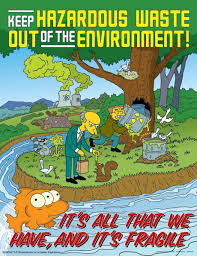
- Scope of Operations
- List of Hazardous materials
- Risk Assessment for Haz Mat transportation
- Security procedures
- Key personnel
Scope of Operations:
Give a brief, concise overview of your business. Identify products and services provided
List of Hazardous Materials:
In this section you’ll give a complete list of Hazardous Materials which may provide a threat when transported in commerce
Personnel and Organization:
Overview the organization of your business. This section should identify all key employees responsible for implementation of the plan. Include names, titles and responsibilities
- First department
- Second department
- Third department
Assessment Information:
In this section you’ll describe the risks probable when transporting hazardous materials. Be sure to include any possible risk while the material is stored at the facility. You should also include a scale which identifies the risk factor for each task or area. For each assessment list all parties involved . Security risks may include Personnel, Vandalism, theft, and using common carriers.
Risk Assessment 1
Risk assessment 2
Security procedures and Controls:
In this section, you’ll describe the procedures that the company will put in place to eliminate, prevent, or minimize the risk.
Hazardous Material Disposal Tips:
DO:
- Keep leftover product in original labeled containers so that you can refer to directions for use and proper disposal.
- Always store in a safe, dry place.
- Share unused materials with others only if product is in its original container with a label.
- Locate firms for recycling oil, antifreeze, and batteries.Drain all containers thoroughly before disposal.
- When the label indicates that containers can be placed in the trash, wrap the empty container in several layers of newspaper and dispose of with other household garbage.
- Triple rinse all containers of water-soluble materials. Use rinse water according to label directions.
DON'T:
- Do not dump leftover products.
- It may be illegal and it contaminates the soil, water, and air.
- Do not burn used or leftover products or product containers.
- Burning may produce toxic fumes.
- Do not bury leftover products or containers in your yard or garden.
- Do not reuse pesticide or other chemical containers for other purposes.
- Do not mix chemical products or wastes.
- Do not put any liquids in the trash.
- Do not put toxic materials such as pesticides in the trash or sewer.
Click the below link to down load the Hazardous material labels & shipping certification

Hazardous Material - Dangerous goods labeling
Hazardous Material - Shipping papers
Hazardous waste - Safety check sheet
